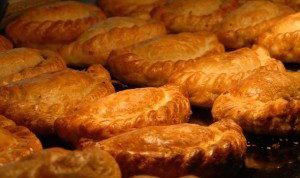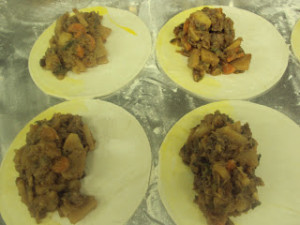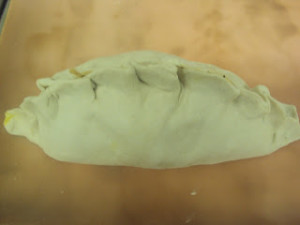It’s cold outside and you probably want something hearty to eat, worry no more I have the perfect recipe for the weekend before you indulge in all that rich Christmas food, from a few years back from when I lived and worked in Cornwall. On a journey through the southwest when you leave cuddly, cosy Devon and its world famous cream teas, scones piled high with clotted cream and jam*, you cross the Tamar river and enter another world. There is something different about Cornwall and it always has been so, it is a magical place, a mythical place, slightly out of step and even out of time with the rest of England. It is a land with a rich history, it was a stronghold of the Celtic resistance to the Roman invasion, Phoenician traders travelled across the seas, over five hundred years ago, to bargain for the tin mined from its stony ground. It is a land of rolling, bleak moors, secret coves and bays hiding smugglers and pirates. Tintagel Castle, birthplace of the once and future King Arthur clings to its rugged coast. Cornwall is the land of the pasty.
 While I lived in Cornwall I made more than a few pasties culminating in a Bank Holiday weekend festival of pasties, real ale, music and more than a little mayhem at the New Inn, Tresco. People watched live bands, drank numerous pints of real ale and scrumpy in the Beer Festival Pavilion and ate pasties, ate pasties and ate more pasties. In fact, I’m pretty sure it could be a world record we sold thousands of pasties from producers all over Cornwall with some very unusual fillings. Peaches and Cream, Lamb Biryani, the Full English Breakfast Pasty ( grandma would approve ** ) to name just a few. I developed quite an aversion to the pasty but now I am slowly recovering.
While I lived in Cornwall I made more than a few pasties culminating in a Bank Holiday weekend festival of pasties, real ale, music and more than a little mayhem at the New Inn, Tresco. People watched live bands, drank numerous pints of real ale and scrumpy in the Beer Festival Pavilion and ate pasties, ate pasties and ate more pasties. In fact, I’m pretty sure it could be a world record we sold thousands of pasties from producers all over Cornwall with some very unusual fillings. Peaches and Cream, Lamb Biryani, the Full English Breakfast Pasty ( grandma would approve ** ) to name just a few. I developed quite an aversion to the pasty but now I am slowly recovering.
So before I upset every Cornish man, woman and child with my totally unauthentic recipe I really ought to mention how it should be made. One of the first references to a meat pasty was made by the thirteenth-century chronicler Matthew Paris ( not the modern Times columnist although I’m sure he could make a mean pasty should he wish ) writing about the diet of the monks of St. Albans. The pasty often filled with venison was a delicacy and is mentioned by Jane Seymour, wife of King Henry VIII and the diarist Samuel Pepys.
As the popularity of the pasty waned nationally the Cornish pasty came into its own. The pasty was a popular filling dish to carry into the deep pits of the Cornish tin mines in the seventh and eighteenth century, wrap in thick pastry and muslin cloth the filling would keep warm for several hours. The pasty was often divided with meat the potato then fruit fillings. The thick twist of pastry was to allow the miners with dirty hands a convenient way to hold the pasty and was then discarded. There may be some truth that this also prevented contamination with the poisonous arsenic present in the tin mines.
A proper pasty is considered to contain beef, sliced potato, onion, and swede. Confusingly in Cornwall, a swede is called a turnip. I am not sure what they call Norwegians. The ingredients are sealed in the pastry with plenty of black pepper and cooked from raw. The Cornish pasty is protected under European law alongside Champagne and Parmesan cheese so the Cornish are right to be proud of their culinary heritage. Here is my recipe for the unauthentic but still quite tasty pasty. If you are Cornish I apologise.
*Always in Devon cream first and jam on top, in Cornwall the jam goes on the scone, it’s best not to ask wars are started over less.
** It is a little known fact all grandmothers don’t think you can get through the day without a hearty full English breakfast inside you. This is no bad thing
Beef and Vegetable Pasties makes 6 – 8
1 block of readymade Puff Pastry
Look I know we have not even got to the filling and I am using puff pastry and that is sacrilege, frozen puff pastry is a godsend to all but the most dedicated of cooks and always delivers a good finished result and they are very tasty I promise and I have apologised already.
500 gr Chuck Steak, cut in small chunks ( ask your butcher if you’re a bit unsure )
1 large White Onion, peeled and sliced
1 medium Swede, peeled and sliced about ½ cm thick
4 Carrots, peeled and sliced
2 large Baking Potatoes, washed, peeled and sliced twice as thick as the swede
50 gr Button Mushrooms, wiped and thinly sliced ( optional )
A knob of butter
A glug of quality Olive Oil
30 gr Plain Flour
300 ml good Beef Stock
Worcestershire sauce
Sea Salt and freshly ground Black Pepper
Flour for dusting
Egg wash
Preheat the oven to 200C / 400F / Gas 6. In a large heavy-bottomed pan heat the oil and butter over a medium heat and add the onion and sauté for five minutes. Seal the meat, flour and plenty of black pepper into a plastic bag and shake well. When the meat is coated add to the pan. Stir and add the carrots, swede, mushrooms and stock. Bring to the boil and simmer for ten minutes stirring occasionally. Add the swede and a good slug of Worcestershire sauce. Cook for a further fifteen minutes until the potatoes are just soft. Check seasoning and set aside to cool.
Flour a clean work surface and roll out pastry to between a quarter and one-eighth of an inch thick. Using a plate cut out circles around six to seven inches in diameter. With a soft pastry brush egg wash one side of the circle. Spoon on a generous amount of filling and pull over pastry.

Crimp together the edges between finger and thumb to seal the pasty and place on a baking tray covered in parchment or with a silicon mat. Continue until all of the filling is used up.
Chill in the refrigerator for twenty minutes to relax the pastry then brush twice with the egg wash. Prick once with the tip of a sharp knife to let out the steam and place in oven. Bake for twenty minutes until golden brown and serve.

